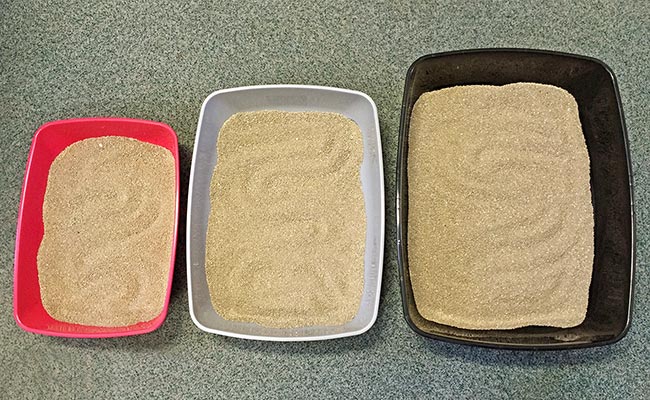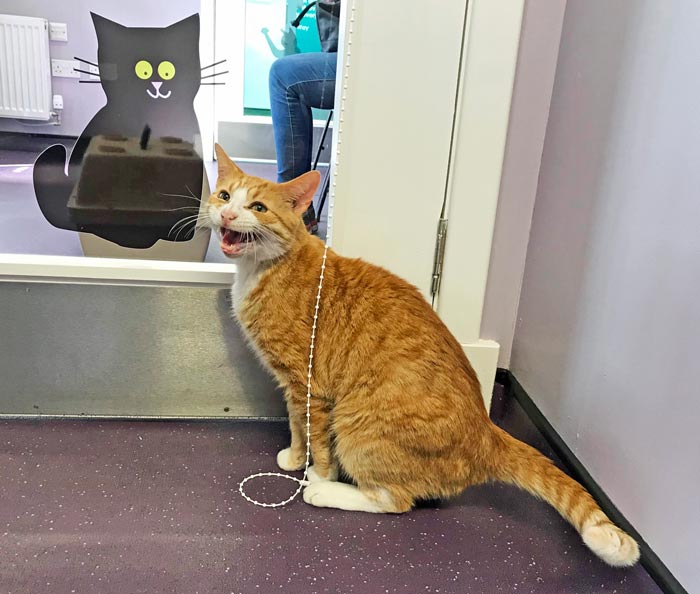22 Oct 2018
Diagnosis and management of cognitive dysfunction syndrome
Sarah Caney describes dementia in older cats and treatment methods, including supplementation and environmental enrichment.

Thanks to better diets and care in general, more of our cats are living to an advanced age. A number of health issues are more common in older cats and preventive health checks are important to identify these at the earliest stage possible, as this will improve the chances of a successful outcome.
Unfortunately, for many illnesses, clinical signs are subtle, gradual in onset and progression, and, therefore, easy for an owner to miss. Many older cats have more than one clinical illness, and this can make diagnosis and management more complicated.
Carers may not be aware of feline dementia as a possibility in their cat. Owner education and support is important to identify affected cats, and provide advice on management. Simple environmental enrichment can make a huge difference to the quality of life of a cat with this condition.
When should a cat be considered old?
International Cat Care has redefined age ranges in association with Hill’s Pet Nutrition. Older cats as are classified as:
- Mature – 7 to 10 years old (equated to a human 44 to 56 years old).
- Senior – 11 to 14 years old (equated to a human 60 to 72 years old).
- Super senior – 15 years or over (equated to a human 76 years or older).
The senior and super senior age categories are most relevant when considering older cats. Preventive health checks are especially important in these life stages as this is when illnesses affecting older cats are most prevalent (Table 1).
| Table 1. Common health problems in older cats | |
|---|---|
| Illness | Comment |
| Cognitive dysfunction | The age-related deterioration in brain function that results in behavioural changes, such as confusion, forgetfulness and altered sleep patterns. This is estimated to affect more than 50% of cats older than 15 years of age. |
| Constipation | |
| Deafness | |
| Dental disease | |
| Diabetes mellitus | Estimated to affect up to 1% of cats. |
| Hyperthyroidism | Estimated to affect about 10% of cats older than 9 years of age. |
| Kidney disease | Estimated to affect about 30% of cats older than 10 years of age. |
| Neoplasia | |
| OA | Estimated to affect more than 90% of cats older than 12 years of age. |
| Systemic hypertension (high blood pressure) | Estimated to affect up to 20% of cats aged 11 and older. Systemic hypertension is most commonly associated with chronic kidney disease, where it is reported to impact on up to 60% of affected cats. |
What health checks are recommended and how often?
International Cat Care has published guidelines on senior and geriatric (now termed “super senior”) health checks.
It advocates:
- Cats of all ages should be assessed at a veterinary practice at least once a year and their weight and body condition score recorded, in addition to a general physical examination, and discussion of appropriate preventive health care.
In addition to this:
- Mature cats should have a blood pressure check, and blood and urine profiles once a year.
- Senior and super senior cats should have a health check every 6 months with a blood pressure check, and blood and urine tests every 6 to 12 months. The author prefers to see senior patients every six months and super senior patients every three months.
What is feline dementia?
Cognitive dysfunction syndrome (CDS) is the medical term for age-related deterioration in brain function and has many similarities with Alzheimer’s disease in people. It is estimated more than half of cats aged 15 years or over are affected by CDS. The cause is not known, but compromised blood flow to the brain and damage resulting from free radicals are believed to play a role in harming the brain tissue.
The cat’s environment has an influence on both progression and protection from CDS. For example, air pollutants may contribute to oxidative damage and, hence, worsen the condition. Noisy environments can be difficult for patients with CDS to cope with and may exacerbate the condition.
The most common clinical signs are behavioural changes, including:
- Altered relationships and social interactions with people and other animals in the home – this can include becoming more “clingy”, aggression and withdrawing from interactions.
- Learning and memory problems, such as litter tray accidents – passing urine and/or faeces outside the litter box.
- Signs of confusion and disorientation – appearing to be lost, even when in a familiar location, staring into space, wandering aimlessly or getting “stuck” in a corner of a room.
- Altered grooming behaviour (increased/decreased).
- Reduced activity levels – exploring less.
- Anxiety and irritability – seeming restless or agitated, vocalising more (especially at night).
- Altered sleep cycles – sleeping more in the day and less at night, vocalising at night.
CDS is a diagnosis of exclusion – other causes of the clinical signs need to be excluded. Differential diagnoses for the aforementioned behavioural changes would include the following, with those in bold considered the most likely in an elderly cat:
- Hyperthyroidism. Irritability, anxiety and vocalisation at night are commonly encountered in cats suffering from hyperthyroidism.
- Systemic hypertension. Hypertensive encephalopathy may result in similar clinical signs to CDS.
- Loss of hearing or vision may result in behavioural clinical signs in patients, so should be considered.
- Chronic pain – for example, associated with OA – can result in some overlapping clinical signs, such as aggression/withdrawal, altered grooming and altered relationships in the home.
- Space-occupying lesions, such as meningioma.
- Infectious diseases associated with neurological signs, such as feline infectious peritonitis (more commonly diagnosed in young than old cats), feline immunodeficiency virus infection, Toxoplasmosis, and so on.
- Metabolic causes of encephalopathic clinical signs, including liver disease, portosystemic shunts and advanced chronic kidney disease.
- Urinary tract infection – in elderly people, urinary tract infections may be associated with symptoms of confusion/dementia, rather than classic lower urinary tract signs. These symptoms tend to be especially severe in patients with pre-existing cognitive dysfunction. It has been suggested elderly cats with urinary tract infections may also show signs of confusion/dementia as one manifestation of their illness.
Behaviour questionnaires can be helpful to identify cats suffering from CDS (Landsberg et al, 2010). A full clinical history, detailed physical examination (including mobility assessment, ocular examination, palpation for a goitre and blood pressure assessment), complete haematology, serum biochemistry and total thyroxine assessment are needed to exclude common differential diagnoses for CDS. Depending on the patient, further investigations, such as advanced imaging of the brain, may be appropriate to rule out differential diagnoses.
CDS cannot be cured and should be considered to be a progressive condition – it will get worse with time. Clinicians should, therefore, do all they can to facilitate early diagnosis of this condition with the aim of providing appropriate supportive interventions.
Environmental modification, enrichment and support should be aimed at stimulating the cat to promote and maintain brain function. Play and toys can be helpful in stimulating growth and the survival of nerves. Environmental enrichment should be employed when the cat is young.
Unfortunately, this type of environmental enrichment can be counterproductive in very badly affected cats, where they cope poorly with change and find play/stimulation stressful. Therefore, if play seems stressful for the cat, it is best to not pursue. Cats in this category benefit from a calm, stable environment where all of their key resources are easy to access.
For the elderly cat that may have concurrent OA, provision should be made for key resources to be readily present in all areas of the home the cat spends time in. Key resources include water, food, rest areas, an area where the cat can hide, if desired, litter trays, and opportunities for play and stimulation.
Elderly cats should have access to a litter box, even if their preferred toilet area has previously been outside in the garden. Easy access to a litter box helps reduce the incidence of periuria/toileting “accidents” in the home. Low-sided boxes are often easier for them to get in and out of. The ideal litter box is 1.5 times the cat’s length, from nose to tail base, and contains a 3cm to 4cm depth of fine, sandy clumping litter (Figure 1).

Where appropriate, supplements/strategies aimed at reducing anxiety should be employed. This may include environmental modification, use of synthetic feline facial pheromone preparations and valerian-containing diffusers, as well as nutraceutical supplements, such as alpha-casozepine.
Diets high in antioxidants and other supportive compounds (for example, essential fatty acids, fish oils, arginine, beta carotene, and vitamins B and E) are believed to reduce oxidative brain damage and help improve cognitive function. One study showed improved cognitive function in cats receiving one such diet (Pan et al, 2013).
S-adenosylmethionine has been assessed in a small number of cats with CDS and found helpful in those with early changes of the condition (Araujo et al, 2012).
No licensed medications exist for CDS in cats, although interest/anecdotal benefit has been reported with a number of compounds, including selegiline and propentofylline.
Excessive vocalisation, especially at night, is a common clinical sign in cats with CDS, and is estimated to affect more than half of elderly cats (Figure 2). Night-time vocalisation can be very distressing for carers.

Tactics to aid management of this include creating a bedroom for the cat to be put into at night. When the owner goes to bed, the cat is given a tasty treat/supper and put into its bedroom as well. All resources the cat needs are also present in this room, which could be the owner’s kitchen, bathroom or spare bedroom. A synthetic feline facial pheromone preparation, with or without a valerian-containing diffuser, may also help provide a sense of calm and reassurance for the cat. Any vocalisation is not acknowledged or rewarded by the owner. The door to the cat’s room is opened in the morning after the owner wakes up.
These tactics usually help to reduce night vocalisation and ensure the owner’s sleep is not disturbed. To be a good carer, it is vital to have appropriate rest and sleep and these tactics are not being cruel to the cat.
Conclusion
CDS is a common feline complaint, but is often under-recognised and under-managed. Knowledge on presenting signs is available, so clinicians should be in a good position to diagnose and manage affected cats. This is particularly important as better cat care means the number of older cats is rising – hence, increasing the number of cats with CDS in all practices.
Many older cats suffer from more than one clinical problem and this can make diagnosis and management more challenging, but it is often possible to significantly improve the quality of life of cats affected by CDS by enriching their environment.
